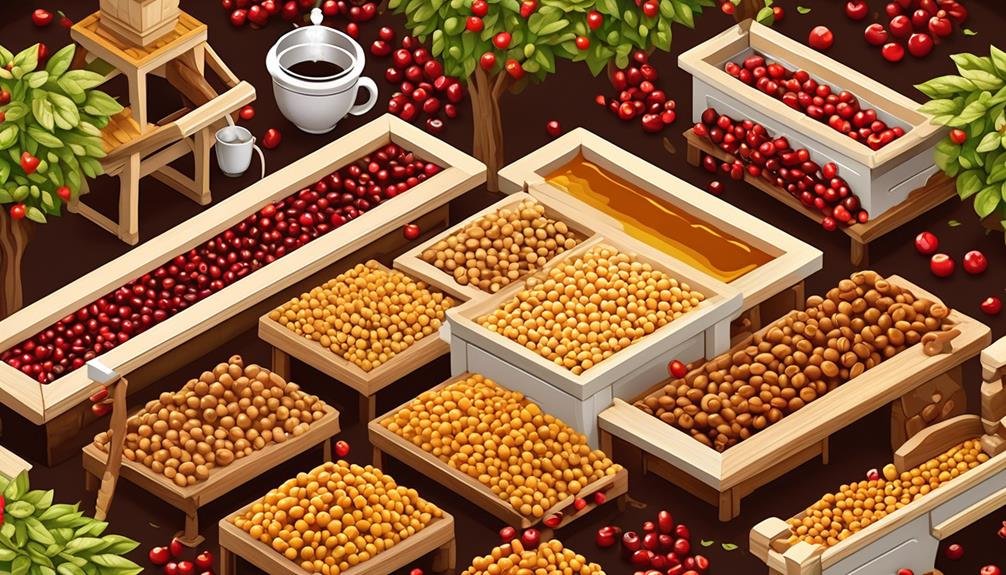Did you know that the way coffee beans are processed can greatly impact the flavor and aroma of your morning cup of joe? It's true!
There are several different methods used to process coffee, each with its own unique characteristics and results. From the traditional washed processing to the intriguing honey processing, the world of coffee processing is as diverse as the flavors it produces.
So, if you're curious to uncover the secrets behind these methods and discover which one might make your taste buds tingle with delight, then join us as we explore the fascinating world of coffee processing.
Key Takeaways
- Washed processing involves removing cherry pulp from coffee beans, resulting in clean and bright flavors.
- Natural processing allows coffee cherries to dry with fruit intact, creating a unique flavor profile that is rich, fruity, and full-bodied.
- Honey processing removes the outer skin of the coffee cherry but leaves some fruit pulp attached, bringing out natural sweetness, acidity, and body.
- Pulped natural processing combines elements of both washed and natural processing, resulting in a complex and balanced flavor profile highly prized by coffee connoisseurs.
Washed Processing
Washed processing, also known as wet processing, is a meticulous method that involves removing the cherry pulp from coffee beans before drying them. This process is widely recognized for producing clean and bright flavors in the cup.
It begins with the freshly harvested cherries being sorted and de-pulped using specialized machines. The beans are then fermented in water for a specific period of time, usually between 12 and 48 hours, to break down the remaining fruit flesh.
After fermentation, the beans are thoroughly washed to remove any remaining pulp or mucilage. This step is crucial as it ensures the removal of any unwanted flavors that could negatively impact the final taste of the coffee.
Following the washing, the beans are dried either under the sun or using mechanical dryers until they reach an optimal moisture content. The result is a coffee bean with a clean, crisp, and well-defined flavor profile.
The washed processing method requires careful monitoring and attention to detail, but the rewards are worth it – a vibrant and nuanced cup of coffee that showcases the inherent qualities of the beans.
Natural Processing
Natural processing, an age-old method cherished by coffee enthusiasts, involves allowing the coffee cherries to dry with the fruit intact, creating a unique flavor profile that's rich, fruity, and full-bodied. This method is widely used in regions with abundant sunshine and low humidity, as it requires the cherries to be spread out on raised beds or patios, allowing them to dry naturally over a period of time.
Here are three reasons why natural processing is so revered among coffee connoisseurs:
- Enhanced sweetness: By leaving the fruit pulp on during the drying process, natural processing imparts a natural sweetness to the coffee beans. The sugars from the fruit are absorbed into the beans, resulting in a delightful, syrupy flavor and a pronounced fruity aroma.
- Intensified fruitiness: Natural processing accentuates the inherent fruity characteristics of the coffee cherries. The extended drying time allows the flavors of the fruit to infuse into the beans, creating a cup that bursts with notes of berries, tropical fruits, and even wine-like undertones.
- Full-bodied mouthfeel: With the fruit intact, natural processing helps to develop a luscious, full-bodied texture in the coffee. The prolonged contact with the cherry skin adds body and depth, resulting in a velvety mouthfeel that lingers on the palate.
Natural processing is a labor-intensive method that demands careful monitoring and attention to detail. However, the resulting cup of coffee is worth the effort, delivering a unique and unforgettable taste experience.
Honey Processing
After experiencing the remarkable flavors and textures of natural processing, it's time to explore another captivating method that showcases the intricacies of coffee: honey processing. This method, also known as pulped natural or semi-washed processing, is gaining popularity among coffee enthusiasts for its unique characteristics and complex flavors.
Honey processing involves removing the outer skin of the coffee cherry, like in the natural process, but leaving some of the sticky fruit pulp, or mucilage, attached to the beans during the drying stage. The name 'honey' comes from the golden and sticky appearance of the beans after this process.
The level of mucilage left on the beans can vary from white (white honey) to yellow (yellow honey) to red (red honey), depending on how much fruit pulp is left intact. The more mucilage left on the beans, the more sweetness and complexity you can expect in the final cup.
During the drying process, the beans are often turned regularly to ensure even drying and prevent fermentation. This meticulous attention to detail contributes to the distinct flavors and aromas associated with honey-processed coffees.
Honey processing has been praised for its ability to bring out the natural sweetness of the coffee while also highlighting its acidity and body. The resulting cup often exhibits a syrupy mouthfeel, vibrant fruit flavors, and a lingering sweetness that's both captivating and satisfying.
Honey processing is a meticulous and labor-intensive method that requires careful monitoring and expertise. However, the unique and delightful flavors it produces make the effort worthwhile. If you're looking to explore the full range of flavors coffee has to offer, honey-processed beans are definitely worth a try.
Pulped Natural Processing
Are you ready to dive into the world of coffee processing and discover the captivating method of pulped natural processing? This unique process combines elements of both washed and natural processing, resulting in a truly distinctive cup of coffee.
Here are three key reasons why pulped natural processing is worth exploring:
- Enhanced sweetness: Pulped natural processing allows the coffee bean to retain a portion of its natural fruit mucilage during drying. This imparts a subtle sweetness to the coffee, creating a complex and balanced flavor profile that's highly prized by coffee connoisseurs.
- Improved acidity: Unlike the full-bodied richness of natural processed coffees, pulped natural processing offers a brighter and more vibrant acidity. This acidity adds a refreshing and lively quality to the coffee, making it a popular choice for those who prefer a brighter cup.
- Consistent quality: Pulped natural processing provides a level of control over the fermentation process that isn't possible with natural processing. This allows coffee producers to achieve a more consistent and predictable flavor profile, ensuring that each batch of coffee meets the high standards set by the industry.
Semi-Washed Processing
Now let's explore the fascinating realm of coffee processing further with the enticing method known as semi-washed processing, which offers a unique twist to the extraction process, resulting in a cup of coffee that's truly unforgettable.
Semi-washed processing, also known as honey processing, strikes a balance between the dry and wet processing methods. In this method, the coffee cherries are picked and then partially pulped, leaving some of the mucilage or pulp intact. The cherries are then spread out on raised beds or patios to dry, with the remaining pulp fermenting and imparting its flavors to the beans.
The result is a coffee that has the sweetness and complexity of natural processing, combined with the cleanliness and clarity of washed processing. The flavors can range from fruity and floral to nutty and chocolatey, depending on the varietal and the degree of fermentation. This method requires careful monitoring and attention to detail to achieve the desired flavor profile.
The semi-washed process is popular in countries like Costa Rica and El Salvador, where it has gained a reputation for producing exceptional coffees. So, if you're looking to experience a truly unique and unforgettable cup of coffee, give the semi-washed process a try. You won't be disappointed.
Frequently Asked Questions
How Does the Coffee Processing Method Affect the Taste of the Coffee?
The coffee processing method has a significant impact on the taste of your coffee. It affects the flavor profile, acidity, and body of the brew. Understanding these methods can help you choose the perfect cup.
Are Certain Coffee Processing Methods More Environmentally Friendly Than Others?
Certain coffee processing methods can indeed be more environmentally friendly than others. By utilizing methods such as washed or honey processing, which use less water or produce less waste, coffee producers can reduce their environmental impact.
Can the Coffee Processing Method Impact the Caffeine Content in the Final Cup?
The coffee processing method you choose can definitely impact the caffeine content in your final cup. Some methods, like the washed process, result in a lower caffeine content, while others, like the natural process, retain more caffeine.
Are There Any Specific Regions or Countries That Are Known for Using a Particular Coffee Processing Method?
There are specific regions and countries that are known for using different coffee processing methods. These methods can vary from region to region, resulting in unique flavors and characteristics in the final cup.
Are There Any Health Benefits or Drawbacks Associated With Different Coffee Processing Methods?
There are indeed health benefits and drawbacks associated with different coffee processing methods. It's important to understand the impact of these methods on the final cup of coffee you enjoy.
Conclusion
In conclusion, the world of coffee processing methods is a fascinating and diverse one. From the crisp and clean flavors of the Washed Processing to the fruity and intense notes of the Natural Processing, each method brings its own unique characteristics to the cup.
The art and science behind these processes require immense skill and dedication, resulting in the aromatic and flavorful brews that coffee enthusiasts cherish. Exploring and appreciating the different processing methods adds another layer of enjoyment to the wonderful world of coffee.




